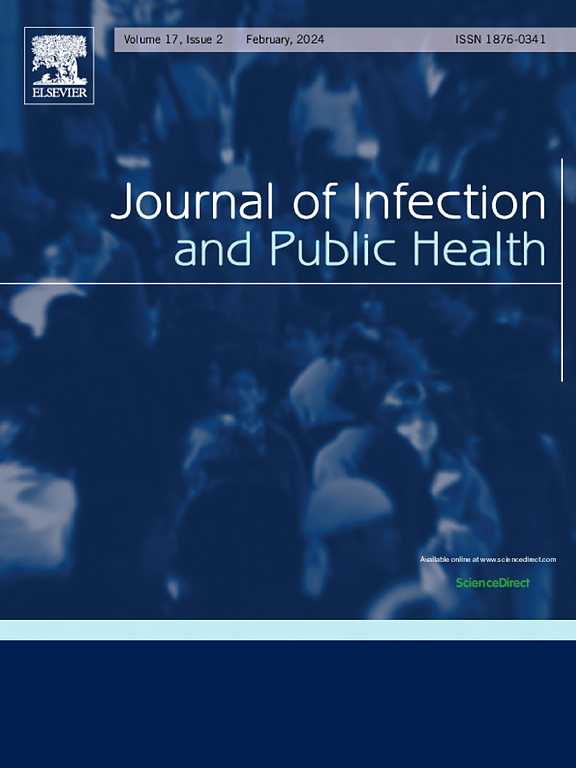Effect of dolutegravir on weight changes and lipid profile compared with efavirenz in people living with HIV: A retrospective cohort study
IF 4.7
3区 医学
Q1 INFECTIOUS DISEASES
引用次数: 0
Abstract
Background
There are limited data on DTG-associated weight gain among treatment-naïve Asian people living with HIV (PLHIV).
Methods
Eighty-one and 100 PLHIV initiating DTG-based and efavirenz (EFV)-based antiretroviral therapy (ART), respectively, were retrospectively investigated for weight changes and lipid profiles at 6 and 12 months after ART initiation.
Results
At baseline, the DTG group had a lower mean body weight (BW) (60.7 kg vs. 64.3 kg, p = 0.071) and lower mean cholesterol level (172 mg/dL vs. 185 mg/dL, p = 0.029) than the EFV group. Mean BW remained lower in the DTG group than in the EFV group at 6 [58.2 kg vs. 66.0 kg, mean difference (MD) −7.8, p = 0.005] and 12 (59.6 kg vs. 67.0 kg, MD −7.3, p = 0.008) months. BW did not significantly change between baseline and 12 months in the DTG group (60.7 kg vs. 59.6 kg, p = 0.495), whereas it significantly increased between baseline and 12 months in the EFV group (64.3 kg vs. 66.9 kg, p = 0.019). Cholesterol levels did not significantly increase between baseline and 12 months in either group. After adjustment, DTG use [MD −5.85, 95 % confidence interval (CI) −10.45, −1.24, p = 0.013] and baseline BW (MD 0.97, 95 % CI 0.79, 1.15, p < 0.001) were significantly associated with BW changes over time.
Conclusions
DTG-based ART was not significantly associated with increased BW and cholesterol levels compared with EFV-based ART in treatment-naïve Thai PLHIV.
与依非韦伦相比,多替格拉韦对HIV感染者体重变化和血脂的影响:一项回顾性队列研究
背景:在treatment-naïve亚洲HIV感染者(PLHIV)中,关于dtg相关体重增加的数据有限。方法:分别对81例和100例PLHIV患者进行基于dtg和基于依非韦伦(EFV)的抗逆转录病毒治疗(ART)后6个月和12个月的体重和血脂变化进行回顾性研究。结果:在基线时,DTG组的平均体重(BW)(60.7 kg vs. 64.3 kg, p = 0.071)和平均胆固醇水平(172 mg/dL vs. 185 mg/dL, p = 0.029)低于EFV组。DTG组的平均体重在6个月[58.2 kg vs. 66.0 kg,平均差值(MD) -7.8, p = 0.005]和12个月(59.6 kg vs. 67.0 kg, MD -7.3, p = 0.008)时仍低于EFV组。DTG组的体重在基线和12个月之间没有显著变化(60.7 kg对59.6 kg, p = 0.495),而EFV组的体重在基线和12个月之间显著增加(64.3 kg对66.9 kg, p = 0.019)。在基线和12个月期间,两组的胆固醇水平都没有显著增加。调整后,DTG的使用[MD -5.85, 95 %置信区间(CI) -10.45, -1.24, p = 0.013]和基线体重(MD 0.97, 95 % CI 0.79, 1.15, p ]结论:在treatment-naïve泰国PLHIV患者中,与基于efv的ART相比,DTG为基础的ART与体重和胆固醇水平升高无显著相关。
本文章由计算机程序翻译,如有差异,请以英文原文为准。
求助全文
约1分钟内获得全文
求助全文
来源期刊

Journal of Infection and Public Health
PUBLIC, ENVIRONMENTAL & OCCUPATIONAL HEALTH -INFECTIOUS DISEASES
CiteScore
13.10
自引率
1.50%
发文量
203
审稿时长
96 days
期刊介绍:
The Journal of Infection and Public Health, first official journal of the Saudi Arabian Ministry of National Guard Health Affairs, King Saud Bin Abdulaziz University for Health Sciences and the Saudi Association for Public Health, aims to be the foremost scientific, peer-reviewed journal encompassing infection prevention and control, microbiology, infectious diseases, public health and the application of healthcare epidemiology to the evaluation of health outcomes. The point of view of the journal is that infection and public health are closely intertwined and that advances in one area will have positive consequences on the other.
The journal will be useful to all health professionals who are partners in the management of patients with communicable diseases, keeping them up to date. The journal is proud to have an international and diverse editorial board that will assist and facilitate the publication of articles that reflect a global view on infection control and public health, as well as emphasizing our focus on supporting the needs of public health practitioners.
It is our aim to improve healthcare by reducing risk of infection and related adverse outcomes by critical review, selection, and dissemination of new and relevant information in the field of infection control, public health and infectious diseases in all healthcare settings and the community.
 求助内容:
求助内容: 应助结果提醒方式:
应助结果提醒方式:


